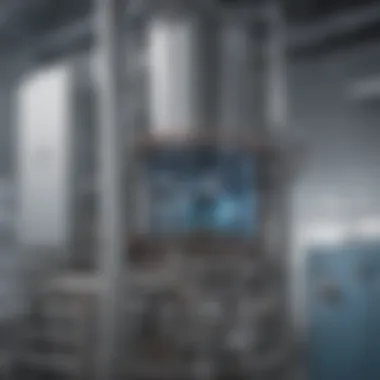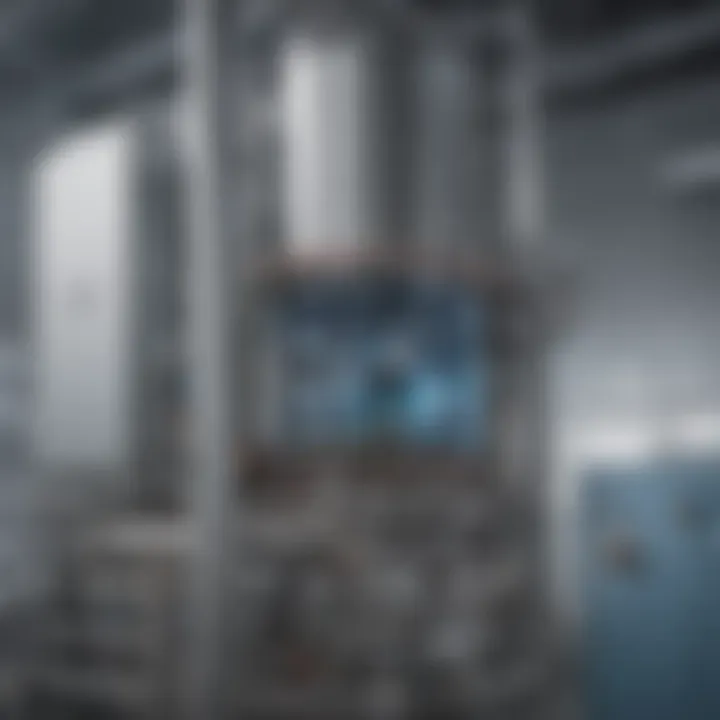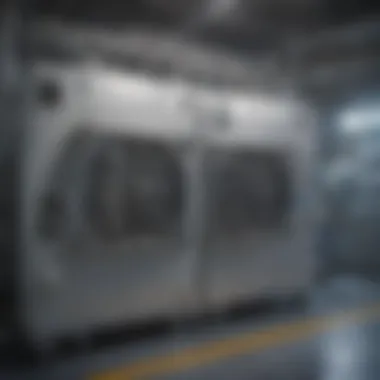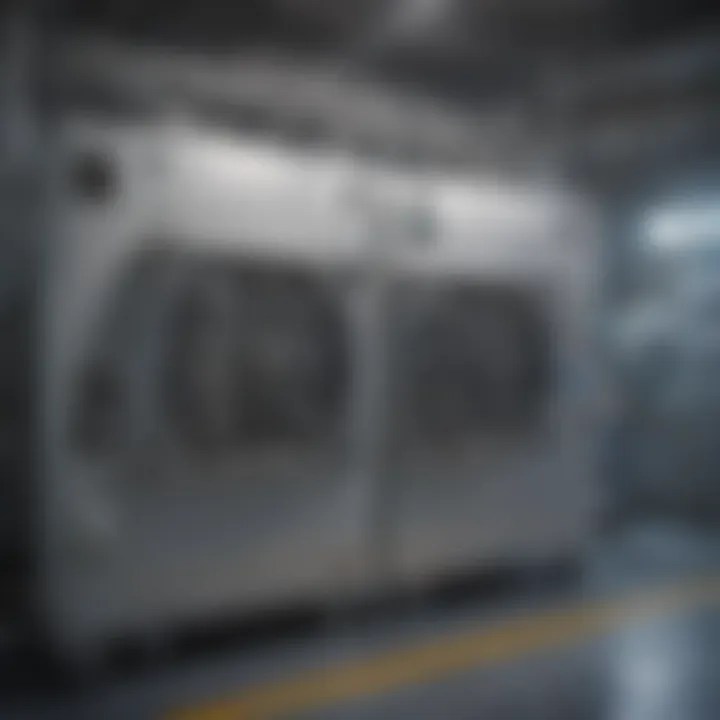In-Depth Look at Chilled Water Evaporators and Their Uses


Intro
Chilled water evaporators play a pivotal role in maintaining the thermal comfort and operational efficiency of various establishments. From sprawling commercial buildings to specific industrial applications, these systems manage heat loads effectively. To comprehend their significance, it's essential to break down how they function, the core principles behind their design, and where they find their application. The intricate workings and efficiencies embedded in chilled water evaporators not only address immediate cooling needs but also reflect innovation and adaptability in engineering practices.
Through this article, we aim to illuminate the underlying mechanics of chilled water evaporators, how they integrate into modern cooling frameworks, and what the future might hold for such technologies. As sustainability becomes crucial in engineering solutions, understanding the shift towards more efficient systems is paramount.
In this examination, you’ll find detailed insights suitable for students, educators, researchers, and professionals alike, enriching your knowledge base and sparking discussions for further investigation.
Prelims to Chilled Water Evaporators
Chilled water evaporators play a critical role in modern cooling systems, serving as the heartbeat of climate control in various settings. Whether it’s about keeping the temperature at bay in massive data centers, ensuring comfort in commercial buildings, or chilling processes in factories, these evaporators are indispensable. Understanding the core concepts surrounding chilled water evaporators is essential for anyone involved in engineering, facility management, or even academia.
What is a Chilled Water Evaporator?
To put it simply, a chilled water evaporator is a device designed to remove heat from water, allowing that water to be used for cooling purposes in air conditioning systems. The primary function is to turn liquid refrigerant into vapor, which absorbs heat from the water circulating through the system. This process effectively decreases the temperature of the water, making it suitable for distribution in various cooling applications, such as air handlers or process cooling lines.
The operation of a chilled water evaporator fundamentally hinges on the principles of phase change and heat transfer. It's not only about cooling water; it’s about establishing a larger environmental control system that operates effectively and efficiently.
Historical Development
Tracing back the history, the evolution of refrigerating machinery has ushered in a profound transformation in our approach to temperature regulation. Early methods utilized natural ice or snow to achieve cooling. The turning point came in the mid-19th century with the creation of mechanical refrigeration systems. This innovation laid the foundation for the development of chilled water systems that we employ today.
From the pioneering work of physicist William Thomson to the introduction of the first commercially viable refrigerators, technology has rapidly advanced. In the late 20th century, advancements in materials science and electronics heralded the arrival of digital controls, which improved efficiency and performance. Nowadays, chilled water evaporators are an amalgamation of sophisticated designs and innovative technologies, showcasing how far we’ve come since the days of relying on ice and snow.
Importance in Modern Applications
In today’s world, chilled water evaporators are finding applications in diverse sectors, and their significance cannot be overstated. Here are a few critical areas where their application is paramount:
- Commercial Buildings: Maintaining a comfortable environment is essential for productivity. Chilled water systems can effectively manage the indoor climate.
- Industrial Processes: Many manufacturing processes require tight temperature controls to ensure product quality and efficiency. Chilled water systems become a necessity in these scenarios.
- Data Centers: The relentless heat generated by servers makes cooling indispensable. Chilled water systems provide an effective solution to keep these sensitive electronics within operational limits.
The growing demand for efficiency and sustainability in cooling solutions often highlights the need for sophisticated systems like chilled water evaporators, making their understanding vital for professionals in the field.
With these insights, we begin to appreciate the delicate balance between technology and application in the world of chilled water evaporators.
Fundamentals of Operation
Understanding the fundamentals of operation of chilled water evaporators is vital for grasping how these systems function in practice. At the core, this understanding allows us to appreciate the intricate dance of thermodynamics, refrigeration cycles, and evaporation principles that together create effective and efficient cooling solutions. With such a critical role in industrial and commercial applications, knowing these fundamentals gives professionals the tools to optimize performance, enhance energy efficiency, and foresee potential issues.
Basic Principles of Evaporation
Evaporation is a process where liquid turns into gas. In the context of chilled water evaporators, this principle is harnessed to absorb heat from the water in the evaporator coil, effectively cooling the water. The process begins when refrigerant enters the evaporator and absorbs heat from the water. This causes the refrigerant to transition from a low-pressure liquid to a vapor, thus carrying away heat. The efficiency of this process is highly dependent on several factors, including the temperature difference between the refrigerant and the water, the flow rate of both media, and surface area available for heat transfer. Understanding these elements is crucial for optimizing evaporator design and enhancing performance.
Refrigeration Cycle Overview
The refrigeration cycle is the backbone of how chilled water evaporators operate. It consists of four main stages: evaporation, compression, condensation, and expansion. During evaporation, the refrigerant absorbs heat from the chilled water to become vapor, as discussed earlier. This vapor is then transported to a compressor, where it is pressurized, raising its temperature significantly. The high-pressure gas enters the condenser, where it releases heat to the surroundings, turning back into a liquid. Once the refrigerant is back in liquid form, it expands through an expansion valve, lowering its pressure before re-entering the evaporator. This cycle repeats continuously, ensuring a stable and efficient cooling process.
"The refrigeration cycle is an essential framework, grounding the principles guiding chilled water evaporators."
Thermodynamics Involved
Diving deeper into thermodynamics, we find it plays a significant role in the behavior and efficiency of chilled water evaporators. The second law of thermodynamics tells us that heat will naturally flow from a hot object to a cooler one, which is the principle harnessed in our refrigeration cycle. Key thermodynamic properties include pressure, temperature, and enthalpy of the refrigerant at various stages of the cycle. The ideal gas laws govern the behavior of the refrigerant, impacting how effectively and efficiently it can absorb and release heat. Understanding these thermodynamic principles is not just for academic interest; in practice, it allows engineers to refine system designs, predict performance under varying conditions, and troubleshoot issues that arise during operation.
In summary, the fundamentals of operation are the bedrock of chilled water evaporator technology. By mastering these foundational elements, professionals can design more effective systems that serve a crucial role in energy-efficient cooling across industries.
Design Considerations
When discussing chilled water evaporators, one cannot overlook the vital role that design considerations play in ensuring optimal performance and efficiency. These elements are fundamental not just for functionality but also for achieving long-term sustainability and cost savings. Identifying the right design aspects ensures the system operates as intended and meets specific project requirements. This section dives deep into key design elements, material selection, and sizing—each contributing to the effectiveness of chilled water evaporators in various applications.
Key Design Elements
A variety of design elements influence the operational efficiency and longevity of chilled water evaporators. First off, the configuration of the evaporator is crucial. For instance, the layout of coils can either promote or restrict heat transfer. It's interesting to note that finned surfaces can enhance heat exchange significantly, which can lead to less energy consumption. Additionally, the arrangement of components—like compressors, heat exchangers, and piping—impacts not only the flow of refrigerant but also the overall system efficiency. Understanding how friction losses and pressure drops are affected by these designs is imperative for any serious practitioner in the field.
Moreover, the integration of user-friendly interfaces for operation and maintenance can’t be understated. A system designed with intuitive controls not only eases operational burdens but also enhances user satisfaction, potentially leading to fewer errors and more effective monitoring.
Selection of Materials
Material selection is another cornerstone of effective evaporator design. The choice often boils down to balancing cost, availability, and performance. For example:
- Copper and Aluminum: Commonly used due to their excellent thermal conductivity.
- Stainless Steel: Preferred in corrosive environments where resilience and durability are necessary.
- Thermoplastics: Gaining popularity for certain applications due to their light weight and resistance to corrosion.
One must also consider the environmental factors that could affect material performance over time. Using materials resistant to corrosion and thermal fatigue can extend the lifespan of the evaporator, providing a more cost-effective solution in the long-run.
Sizing and Capacity Planning


Sizing and capacity planning are ultimately related to the intended application of the chilled water evaporators. It's critical to undertake a comprehensive analysis that considers:
- Expected cooling load: An accurate assessment of the thermal load helps in selecting the right evaporator size.
- Variable operating conditions: Seasonal changes can affect performance, so one should analyze various environmental influences.
- Potential for future expansions: It's wise to consider future facility growth or changes in demand when selecting evaporator capacity.
A well-sized evaporator will minimize energy expenditure while maximizing cooling efficiency. Over-sizing leads to inefficient energy use, while under-sizing can compromise performance, leading to operational hurdles and system stress. Therefore, precise calculations and modeling during the design phase are not just advisable; they are essential.
Effective design considerations in chilled water evaporators can significantly impact energy efficiency, operational reliability, and user satisfaction.
By thoroughly addressing these design elements, material choices, and sizing strategies, one can greatly enhance the effectiveness of chilled water evaporators across varied applications. This foundational knowledge forms the bedrock upon which efficient and robust cooling systems are built.
Types of Chilled Water Evaporators
Understanding the different types of chilled water evaporators is paramount for selecting the right system for various applications. Each type of evaporator—air-cooled, water-cooled, and hybrid—offers distinct advantages and disadvantages, depending on the specific needs and conditions of the installation site. This part of the article delves into the characteristics of each type, emphasizing their operational mechanisms, energy efficiencies, and ideal environments for use. Selecting the right type can greatly affect operational costs and environmental impact.
Air-Cooled Evaporators
Air-cooled evaporators are one of the most commonly used types in applications where water availability is limited. These systems rely on ambient air to carry away heat from the refrigerant during the evaporation process. The simplicity of air-cooled evaporators makes them appealing for a number of settings.
Advantages:
- Installation Flexibility: Air-cooled systems are generally easier to install, as they don't require complex piping for water movement.
- Lower Initial Costs: They typically have a lower upfront cost compared to water-cooled systems.
- Reduced Risk of Scaling: As they do not use water, these systems aren’t prone to scaling and corrosion, which can happen in water-cooled systems.
Considerations:
- Efficiency Limitations: In high-temperature environments, air-cooled systems can struggle with efficiency, as the ambient air may not be cool enough to effectively absorb heat.
- Noise Levels: Some air-cooled condensers can produce more noise than their water-cooled counterparts, which might be a concern in noise-sensitive locations.
These units are well-suited for small to mid-sized buildings and places where water conservation is essential, providing a manageable and cost-effective solution for moderate cooling demands.
Water-Cooled Evaporators
Water-cooled evaporators operate by using a dedicated water source—such as cooling towers or wells—to carry away heat from the refrigerant. These systems typically manage heat exchange more effectively than air-cooled systems, offering superior efficiency, especially in larger installations.
Advantages:
- Higher Efficiencies: Water-cooled units are often more efficient in removing heat, leading to lower operational costs in suitable environments.
- Compact Design: They tend to require less space than air-cooled systems, making them suitable for installations with limited outdoor space.
Considerations:
- Water Requirements: They rely heavily on a consistent water source, which may not be available or economically viable in some regions.
- Maintenance Needs: Regular maintenance is usually required to manage the cooling tower and prevent issues like algae growth or scaling.
Water-cooled evaporators are frequently found in commercial buildings, large industrial plants, and data centers, proving beneficial where cooling demands are substantial.
Hybrid Systems
Hybrid systems combine elements of both air-cooled and water-cooled evaporators, striving to optimize performance by switching between the two cooling methods based on environmental conditions. This flexibility can lead to higher efficiencies across various operational scenarios.
Advantages:
- Versatility: Hybrid systems can adjust to weather and operational changes, providing superior adaptability.
- Improved Performance in Fluctuating Conditions: This type of evaporator can operate efficiently across a broader range of conditions, extending its applicability.
Considerations:
- Complexity in Design: The hybrid nature can lead to more intricate design requirements and potentially higher costs and maintenance demands.
- Initial Investment: The initial investment might be higher due to the sophisticated nature of these systems.
Hybrid systems prove useful in environments with variable load conditions, offering an innovative solution for demanding cooling requirements. By understanding the features and functionalities of these different evaporator types, stakeholders can make informed decisions that align with their operational goals and sustainability targets.
"Choosing the right type of evaporator can dramatically affect the efficiency and effectiveness of your cooling system."
In summary, this exploration of chilled water evaporators sheds light on their varying designs, enabling decision-makers to consider environmental impact, operational costs, and specific cooling needs before installation.
Efficiency Metrics
Understanding how chilled water evaporators function is not only essential in grasping their mechanics but crucial in determining their efficacy in real-world scenarios. Efficiency metrics provide a quantitative foundation upon which components of these systems can be understood. They guide engineers and facility managers, helping them make informed choices while designing or maintaining cooling systems. Evaluating these performance markers translates directly to operational success, impacting cost-effectiveness and energy sustainability.
Coefficient of Performance
The Coefficient of Performance (COP) serves as a primary indicator of a chilled water evaporator’s efficiency. It’s a ratio that defines the relationship between the cooling output and the energy input. Simply put, the higher the COP, the better the system is at transforming energy into cooling.
In practical terms, if an evaporator has a COP of 4, for every unit of energy consumed, it produces four units of cooling. Much like a seasoned chef assessing the results of a recipe, engineers review COP ratings to gauge performance. Factors influencing the COP include temperature differences between the evaporator and the surroundings, the system’s design, and the operational conditions.
- Higher COP Values: A higher value not only lowers electricity bills but also signifies less environmental impact, aligning with sustainable practices in engineering.
- Balance of Conditions: However, this metric can also fluctuate significantly based on environmental conditions, such as ambient temperature and humidity, making it essential to consider COP in various scenarios.
"In the quest for cooling efficiency, the COP stands as a beacon—guiding choices that shape economic and environmental outcomes."


Energy Consumption Analysis
Energy consumption analysis dives deeper into understanding how much energy is actually utilized during the operation of the evaporators. An effective analysis does not merely take the COP into account but looks at a range of operational metrics, identifying patterns and areas for improvement.
This assessment can help:
- Optimize Operations: By analyzing energy patterns, operators can fine-tune settings for day and night cycles or during peak usage periods.
- Lifecycle Costing: It also plays a pivotal role in lifecycle cost analysis, revealing the energy costs over time, rather than just upfront capital expenditure. This understanding aids businesses in planning budgets more efficiently.
- Benchmarking: Monitor efficiency against similar setups, granting insights into potential upgrades and innovations.
Performance Under Variable Conditions
Chilled water evaporators face variable conditions constantly, influencing their performance. Seasonal changes, alterations in load, and ambient temperature fluctuations can all play a role in how well they operate.
To analyze performance in varied conditions, consider the following:
- Load Variability: Systems often encounter load changes throughout the day. A chilled water system should be robust enough to adjust to these demands without significant efficiency loss.
- Impact of Temperature Changes: Lower outdoor temperatures can enhance performance due to reduced ambient heat pressure, while excessively high temperatures may hinder efficiency, creating strain on the system.
- Proactive Maintenance: Understanding how a system behaves in different conditions is vital for determining maintenance schedules. For instance, anticipating when filters may need cleaning can prevent unexpected drops in performance.
By focusing on these metrics and considerations, professionals can ensure that chilled water evaporators not only meet the demands of today but are also prepared for the challenges ahead. Engaging with these details fosters a proactive culture around system management and supports sustainable practices in cooling technology.
Control Systems and Automation
Control systems and automation play a pivotal role in the effectiveness and efficiency of chilled water evaporators. As the complexities of modern cooling requirements evolve, leveraging sophisticated control systems becomes essential. These systems help monitor, manage, and optimize the operations of evaporators, leading to enhanced performance and lower operational costs.
Smart Controls in Cooling Applications
Smart controls have changed the landscape of cooling applications in numerous ways. By utilizing programmable logic controllers and advanced sensors, smart controls facilitate precise temperature regulation and energy management. This means that cooling can be tailored to suit the specific demands of different environments, optimizing energy consumption.
For instance, in a commercial building, smart controls can adjust cooling levels based on occupancy patterns. If a space is empty, the system can reduce cooling, saving energy without sacrificing comfort. Furthermore, these controls often feature self-learning algorithms that analyze historical data, enabling them to predict cooling needs more accurately over time.
- Benefits of Smart Controls include:
- Energy efficiency: Reduces unnecessary energy consumption.
- Operational flexibility: Adapts to changing conditions.
- Enhanced comfort: Maintains optimal temperatures.
Integration with Building Management Systems
Integrating chilled water evaporators with building management systems (BMS) is another significant step towards efficient cooling operations. A BMS allows for the centralized monitoring of all HVAC systems, including evaporators. This integration ensures that all components work seamlessly together to achieve optimal performance.
When developers design buildings, BMS can be used to create a comprehensive cooling strategy. For example, temperature and humidity sensors linked to a BMS can adjust chilled water flow rates, responding to real-time conditions. As a result, cooling systems can be more responsive, improving overall building efficiency.
Moreover, integrating with a BMS enables:
- Data Analysis: Continuous monitoring and reporting can highlight areas where performance can be enhanced.
- Predictive Maintenance: Detect and address potential issues before they escalate, saving time and costs.
Remote Monitoring Solutions
In today's increasingly digital world, remote monitoring solutions offer another layer of sophistication in managing chilled water evaporators. Through cloud-based platforms, facility managers can monitor systems from virtually any location. This capability not only enhances operational visibility but also allows for quicker responses to potential issues.
Remote monitoring systems typically include:
- Alerts and Notifications: Instant notifications are sent for abnormalities, helping prevent emergencies.
- Performance Reports: Detailed insights can be generated regarding the efficiency and usage patterns of the evaporators.
- Remote Adjustments: Authorized personnel can sometimes make system adjustments without being physically present, fostering efficiency.
By embracing remote monitoring solutions, industries can achieve enhanced oversight of their cooling systems, ultimately leading to improved reliability and uptime.
In summary, effective control systems and automation facilitate better management of chilled water evaporators. Through smart controls, integrations with building management systems, and remote monitoring options, organizations can enhance energy efficiency and performance while adapting to changing cooling needs.
Applications Across Industries
Chilled water evaporators serve a pivotal role across various sectors. Understanding their applications is essential for anyone involved in engineering, facility management, or operational strategy. These systems not only help in temperature regulation but significantly contribute to operational efficiency and energy management. They find their place in a wide array of environments—from commercial properties to intricate industrial processes. The effective deployment of chilled water evaporators can lead to reduced operational costs, enhanced environmental footprints, and ultimately, improved service delivery.
Commercial Buildings
In the realm of commercial buildings, chilled water evaporators are indispensable. They facilitate climate control, ensuring comfortable indoor environments for both tenants and visitors. Notably, modern office spaces, retail outlets and hospitality sectors leverage these systems to maintain optimal temperature settings.
One key benefit of their use in commercial settings is energy efficiency. Many facilities employ energy recovery systems, integrating chilled water evaporators with existing HVAC systems. This can lead to a reduction in peak-demand energy costs—an immediate financial boon. Furthermore, the implementation of smart controls allows for real-time monitoring and adjustments based on occupancy and external weather conditions.
"Utilizing chilled water systems can decrease energy consumption by up to 30% compared to traditional cooling methods."
The flexibility in system design enables customization tailored to specific building layouts. This adaptability can enhance the utility of available resources, virtually eliminating dead zones in cooling coverage. However, the choice of materials and design considerations must align with the specific requirements of the building's architecture and usage patterns.
Industrial Processes
Industrial applications of chilled water evaporators differ significantly in their scope and complexity. In manufacturing lines—from food and beverage to pharmaceuticals—consistent temperature control is crucial. It prevents spoilage, maintains product quality, and enhances safety protocols. For instance, in places where heat generated is an inevitable by-product of production, the utilization of chilled water evaporators can counteract temperature spikes, safeguarding both equipment and processes.
It’s also noteworthy that some industries require stringent temperature limitations for compliance and regulatory standards. Chilled water systems can be designed to meet precise thermal criteria, thereby ensuring operations align with industry regulations. Consider, for example, a chemical plant utilizing evaporators for process cooling; here, even slight temperature fluctuations can compromise production quality. Thus, precision in temperature regulation supported by advanced chilled water systems is critical.


Moreover, chilled water evaporators contribute to sustainability goals. Many industrial facilities are moving towards greener operations, using systems designed for lower power consumption and reduced waste. This shift not only enhances a company’s ecological footprint but also positions it favorably among environmentally conscious consumers.
Data Centers
In today's digital age, data centers are emerging as one of the most intensive users of cooling technologies, including chilled water evaporators. These facilities house critical infrastructures that sustain global communications and computing needs. The primary challenge here revolves around managing heat generated by high-density server installations. A single data center can consume megawatts of power, necessitating efficient cooling solutions that do not hinder operational costs.
The chilled water approach offers a balanced solution. By maintaining lower operating temperatures, data centers can enhance system performance while extending the lifespan of the equipment. The integration of chilled water evaporators with advanced cooling techniques can drastically improve energy efficiency.
It’s also important to highlight the role of scalability within data center operations. As demands fluctuate with cloud computing trends, facilities require scalable cooling solutions that can adapt as needed. Chilled water evaporators provide a versatile platform, accommodating changing loads with relative ease.
Finally, advancements in remote monitoring and control systems can optimize performance in real-time, allowing for adjustments based on server load and environmental factors, keeping operational costs down while ensuring reliability.
Challenges and Solutions
The realm of chilled water evaporators is filled with several challenges that professionals must navigate. As our industries evolve—often at the speed of light—understanding these challenges and the potential solutions is critical. By tackling these hurdles, we can ensure efficiency, sustainability, and resilience in various applications.
Maintenance Considerations
Maintenance is crucial for the longevity of chilled water evaporators. Regular upkeep ensures they remain operational and perform at optimal efficiency. Ignoring maintenance can lead to costly downtimes or even permanent failure of the system.
- Cleanliness is Key: The evaporator coils should be clean to facilitate proper heat exchange. Dirt and debris can accumulate, lowering efficiency and pushing energy consumption through the roof.
- Routine Inspections: Regularly inspecting for leaks, corrosion, or any component that shows signs of wear is vital. A small problem can snowball into a much bigger one if not dealt with promptly.
- Water Quality: The quality of the water circulating through the system matters significantly. Mineral deposits can accumulate, leading to scaling inside the evaporator, which serves to insulate the coils, thus reducing heat transfer and increasing energy usage.
"Preventative measures are far cheaper than repairs in the long run. A stitch in time saves nine!"
Environmental Concerns
The operational nature of chilled water evaporators often raises environmental concerns. The energy used in these systems significantly contributes to overall emissions, especially in larger installations.
- Energy Consumption: High energy use translates to a larger carbon footprint. This is a pressing issue in today's world where sustainability is at the forefront of design.
- Refrigerants: The type of refrigerant used in these systems has substantial implications for the environment. Some refrigerants have high global warming potential (GWP). It is crucial to transition to low or zero GWP alternatives.
- Water Usage: Large cooling systems can demand significant water resources, leading to potential strain on local water supplies. Careful management of chilled water systems can mitigate this impact.
Technological Innovations
In addressing the challenges faced, technological advancements serve as a beacon of hope. Innovations in this field not only optimize performance but also enhance sustainability efforts.
- Smart Technology: Integrating IoT technology allows real-time monitoring of evaporators. This means that any deviations from optimal performance can be corrected immediately, leading to savings in energy and resources.
- Advanced Materials: The development of new corrosion-resistant materials can extend the life of components. Enhanced materials can also improve thermal transfer efficiency, thereby increasing overall performance without substantial energy costs.
- Artificial Intelligence: Leveraging AI for predictive maintenance can reduce costs and downtime. Using algorithms that analyze operational data can pinpoint potential failures before they occur, enabling focused maintenance efforts.
In summary, tackling these challenges in maintenance, environmental impact, and the use of technology can greatly enhance the efficacy of chilled water evaporators. Moving forward, it’s essential for professionals to stay informed and adapt, as this field continues to develop at a rapid pace.
Future Trends in Chilled Water Evaporators
The realm of chilled water evaporators is evolving at a rapid pace. The significance of understanding these advancements lies not only in improving efficient operation but also in aligning with sustainable practices that are more crucial than ever. With mounting pressure to reduce energy consumption and the environmental footprint of industrial applications, identifying trends is imperative for both practitioners and researchers in this field.
Emerging Technologies
Today, innovative technologies are redefining the landscape of chilled water evaporators. One of the most noteworthy advancements is the integration of smart technologies in these systems. Technologies such as Internet of Things (IoT) sensors enable real-time monitoring and analytics. These sensors gather data on temperature, humidity, and energy usage, allowing for proactive optimization of operations.
Artificial Intelligence (AI) is also making strides, with algorithms that can predict failures and automate maintenance schedules, minimizing downtime. As facilities seek greater precision and reliability, these technologies serve as game-changers. Increasing adoption of variable speed drives enhances compressor efficiency and overall system performance, providing manufacturers and end-users a compelling reason to upgrade.
Sustainability and Energy Efficiency
With climate change at the forefront of global concerns, sustainability in cooling technologies has taken center stage. Chilled water evaporators are increasingly being designed with energy efficiency in mind. Optimizing heat exchanger designs not only enhances thermal performance but also reduces energy consumption.
Moreover, alternative refrigerants like hydrofluoroolefins (HFOs) are gaining traction as environmentally friendly options, reducing greenhouse gas emissions. Such shifts in refrigerant usage align with international protocols aimed at phasing out harmful substances. This emphasis on sustainability isn't just an ethical choice; it also often leads to cost savings in operational expenses in the long run.
Regulatory and Policy Impacts
As industries worldwide pivot towards sustainability, regulatory frameworks are becoming more stringent. Governments are setting ambitious targets for energy efficiency and greenhouse gas emission reductions. Consequently, facilities operating with chilled water evaporators must stay ahead of these regulations.
Policies that promote the adoption of energy-efficient technologies are emerging in more regions. For instance, incentives or tax breaks for utilizing advanced cooling systems can encourage investment in newer evaporator designs. Companies that stay informed and adapt to these regulations aren’t just compliant—they often find themselves at a competitive edge in their respective markets.
"Adapt or get left behind"—this saying rings particularly true in the realm of evaporators, where evolving technologies and regulatory landscapes demand a proactive approach.
The End
In wrapping up our exploration of chilled water evaporators, it’s clear that these systems play a critical role in modern climate control within various industrial and commercial applications. The importance of this topic cannot be overstated, given the increasing demand for efficient cooling solutions that align with sustainability goals. As businesses strive for energy efficiency and lower operational costs, understanding the nuances of chilled water evaporators becomes integral.
Summary of Key Insights
Throughout this article, several key insights emerged regarding chilled water evaporators:
- Design and Functionality: The intricate design elements and operational principles of these evaporators were discussed. Their capacity to regulate temperature effectively hinges on a well-structured refrigeration cycle, which is pivotal for the performance and reliability of these systems.
- Diverse Applications: From commercial buildings to data centers, the versatility of chilled water evaporators illustrates their relevance in varying sectors. Each application demands specific adaptations, highlighting the necessity of tailored solutions.
- Efficiency Metrics: Analyzing various efficiency metrics, such as the coefficient of performance, sheds light on how well these systems perform under different conditions. This is essential for optimization and for meeting energy consumption goals.
- Future Trends: Observations about emerging technologies and regulatory impacts suggest that the world of chilled water evaporators is in flux. Innovations toward sustainability and efficiency are pivotal to future developments in the field.
Future Directions for Research
Research in the chilled water evaporators domain should focus on several promising areas:
- Innovations in Material Science: Exploring new materials that enhance thermal conductivity and reduce energy loss could significantly improve the efficiency of evaporators.
- Integration with Renewable Energy: Future studies could investigate how these evaporators can be integrated with solar or wind energy systems, providing a more sustainable cooling solution.
- Smart Technology: Further research into smart controls and automation systems might yield insights that lead to better energy management and optimized performance in real-time.
- Environmental Impact Assessments: As sustainability becomes a focal point, there's an urgent need for research that quantifies the environmental impacts of chilled water systems, leading to better design and operational practices.
“The future direction of chilled water evaporators hinges on innovation, sustainability, and integration with advanced technologies.”
In summary, chilled water evaporators are vital for effective cooling in various environments, and understanding their design, function, and efficiency can elevate their applications while promoting sustainability. Continued research and development in this sphere will be essential for advancing both technology and environmental goals.







